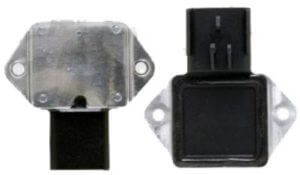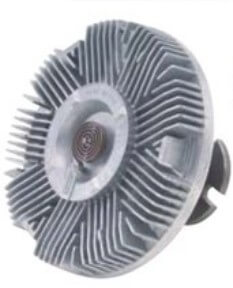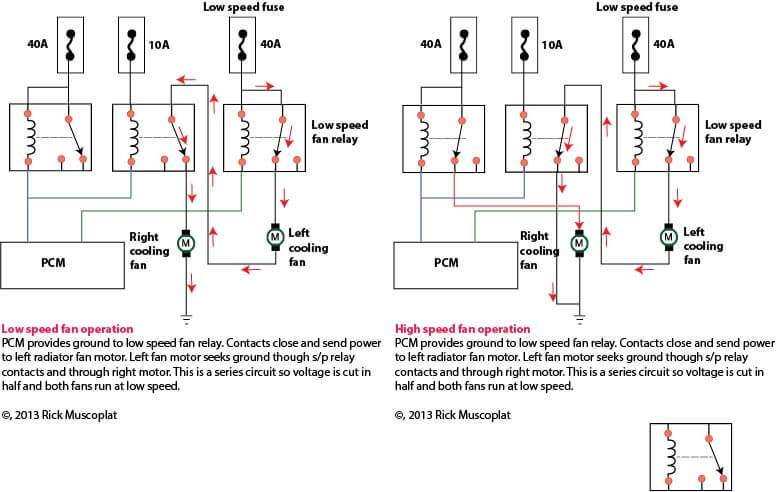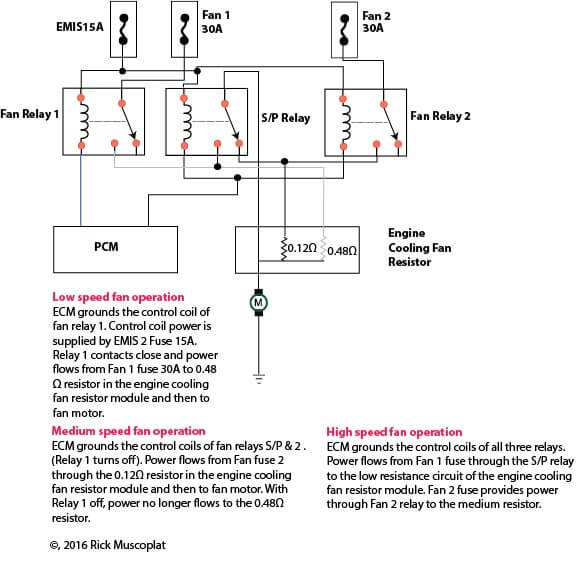Engine overheats — how to diagnose
Engine overheats — What to check
If your engine overheats, here are the most common causes. To diagnose it properly, we need a bit more information.
• Is it overheating at highway speeds, or
• Is it overheating in stop and go traffic, or
• Does your car overheat only when stopped and idling?
First things to check if your engine overheats in city driving or at stops.
#1 Check your coolant level. If there’s no coolant in the reservoir, you’ve got a leak or a head gasket problem where the engine is burning up the coolant. In other words, the coolant is going somewhere and you have to find out where it’s going.
#2 Check the radiator fan operation. Your vehicle may have one or more electric radiator fans. They can be single, multi-speed or variable speed electric fans. Or, your radiator fan may be a engine driven with a viscous thermo clutch.
Your car AC cannot operate properly in stop and go traffic or at a full stop if your radiator fans aren’t working properly. This is the first thing to check if your car AC works well at highway speeds but not in city driving or at stops.
#3 Check for debris clogging the radiator fins
Low coolant level can cause an engine overheats when stopped situation
You may have just enough coolant in your engine to keep it at an acceptable level when the water pump is spinning at high speeds while driving. But when you stop for a light or stop sign, a low coolant level can cause overheating. There just isn’t enough coolant in the system to cool all the internal components.
GM uses three relays to make its radiator fans run at two or three speeds.
Many GM cars use three relays to make the radiator fans run at two speeds. If just one relay fails, the fans can’t run at a high speed. See this wiring diagram.
Radiator fan wiring diagram for 3-speed fans
Chrysler uses a digital fan controller to regulate radiator fan speeds
The Chrysler fan control gets speed commands from the PCM and changes the radiator fan speeds based on the temperature of the coolant. This “cooling fan relay” requires a good ground and a “heat sink” to keep them cool and prevent failure.
In a total lack of foresight, Chrysler mounted the cooling fan relay on a frame member near  the bottom of the engine compartment, where it’s exposed to road salt and water. The back of the relay is a heat sink, so it must touch the metal frame to dissipate heat buildup. When the frame rusts, the relay overheats and fails.
the bottom of the engine compartment, where it’s exposed to road salt and water. The back of the relay is a heat sink, so it must touch the metal frame to dissipate heat buildup. When the frame rusts, the relay overheats and fails.
If you simply replace the relay without removing the corrosion, you’ll have another failure. To do the job right, remove the corrosion and coat the cleaned frame member with dielectric grease before replacing the relay.
A failed mechanical radiator fan clutch can cause engine overheating
Carmakers sometimes install a viscous clutch on mechanically driven radiator fan s. The clutch allows the fan to free-wheel at highway speeds to reduce engine drag. The use of a viscous clutch eliminates that drag. The clutch contains a silicone fluid that makes the connection between the pulley and the fan when the engine is operating at lower RPMs and disengages at higher RPMs.
s. The clutch allows the fan to free-wheel at highway speeds to reduce engine drag. The use of a viscous clutch eliminates that drag. The clutch contains a silicone fluid that makes the connection between the pulley and the fan when the engine is operating at lower RPMs and disengages at higher RPMs.
What goes wrong with a viscous fan clutch?
Older viscous fan clutches have a bi-metallic spring that regulates silicone pressure. When that system fails, the fan goes into free-wheeling mode at all times. So you’ll get some cooling at highway speeds, but the car can overheat when stopped. Replacing the radiator fan clutch solves that problem.
Newer cars and trucks use an electronically controlled viscous fan clutch. GM, for example, uses an electronically controlled fan clutch. Unfortunately, the early models had a very high failure rate. If you have a mechanically driven radiator fan equipped with an electronically controlled viscous clutch and your car overheats when stopped, suspect a bad clutch.
A clogged radiator can cause overheating when stopped
At higher speeds, a clogged radiator may be able to flow and cool enough coolant to keep your engine cool. But if your car overheats when stopped, there’s a good chance the radiator is clogged.
Check the radiator fins for clogging
Shine a flashlight down the fins on the grille side of the radiator. Bugs, road dirt, and corrosion can prevent proper airflow. If the radiator is clean, but the car has A/C, check the condition of the condenser coil, since it sits in front of the radiator. If you see buildup on the fins, rinse with a garden hose nozzle until clean.
Check the radiator for internal clogging
The easiest way to check the radiator is to use a non-contact infra-red thermometer. Scan across the radiator. Clogs will show up as cool spots, while the rest of the radiator will be hot.
What to check if your car is overheating at highway speeds
A failing water pump can cause the engine to overheat
The fins on the water pump impeller may be worn and pump enough coolant at slower speeds but then create cavitation at higher speeds. The cavitation introduces air bubbles throughout the cooling system, which reduces cooling efficiency, The cavitation can also wear away the metal surfaces in the water pump, further reducing pump efficiency. While a worn pump can sometimes cause overheating at highway speeds, it also causes overheating at slow or stopped conditions as well.
A radiator fan can’t work properly if the seals and shrouds are cracked or missing
Late-model cars have rubber and foam seals around the radiator to prevent air from bypassing around the radiator. If you’ve had radiator repair work done and the seals aren’t put back in the same place or are left out, air can flow around the sides of the radiator and reduce cooling. The same applies to radiator fan shrouds. Then must be intact and installed properly to create the proper airflow when the vehicle is running at highway speeds.
A failed viscous clutch can cause the engine to overheat
A viscous clutch is designed to allow the mechanically driven radiator fan to free-wheel at highway speeds. If the clutch fails and the fan is still being driven by engine speed when the vehicle is at highway speeds, the fan may actually be running slower than the ram air coming in through the radiator. In that case, the radiator fan can slow airflow and cause a car overheating condition.
A failed head gasket can cause the engine to overheat
If a head gasket fails between a cylinder and a coolant passage, the engine can force hot exhaust gasses into the coolant, substantially raising the temperature of the coolant to the point where it can’t be cooled enough by the radiator. See this post for help diagnosing a head gasket failure.
© 2016 Rick Muscoplat
Posted on by Rick Muscoplat


